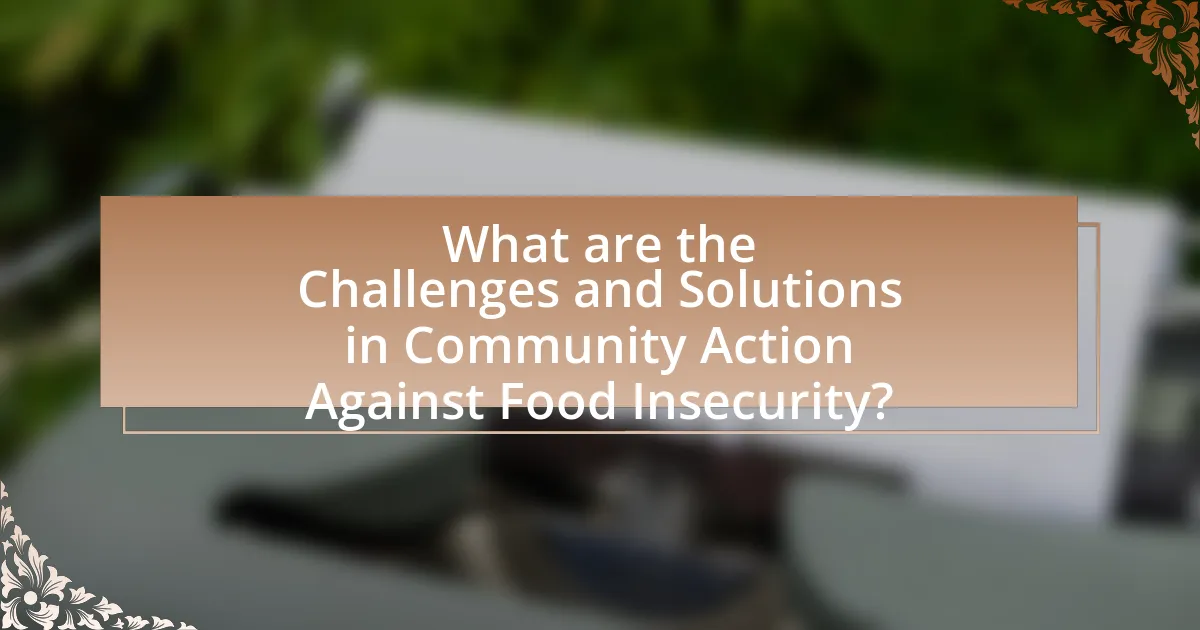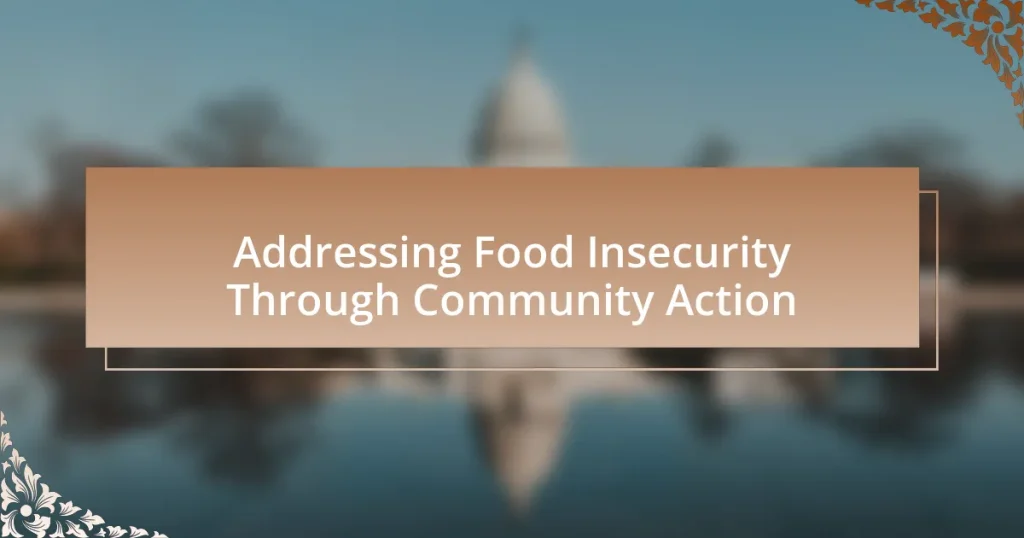Food insecurity is defined as the lack of consistent access to enough food for an active, healthy life, affecting millions globally and linked to negative health outcomes. The article explores the multifaceted nature of food insecurity, including its definitions, key indicators, root causes, and the impact on health and well-being. It emphasizes the importance of community action in addressing food insecurity through strategies such as community gardens, food banks, and localized food systems. Additionally, it discusses the role of economic factors, social inequality, and the necessity for collaboration among stakeholders to create sustainable solutions. The article highlights successful case studies and best practices that demonstrate effective community-driven initiatives in combating food insecurity.

What is Food Insecurity and Why is it a Concern?
Food insecurity is the lack of consistent access to enough food for an active, healthy life. This condition affects millions globally, with the United States Department of Agriculture reporting that in 2021, approximately 10.2% of U.S. households experienced food insecurity at some point during the year. The concern arises because food insecurity is linked to negative health outcomes, including higher rates of chronic diseases, mental health issues, and developmental problems in children. Addressing food insecurity is crucial for improving public health, reducing healthcare costs, and fostering economic stability within communities.
How is food insecurity defined in different contexts?
Food insecurity is defined as the lack of consistent access to enough food for an active, healthy life, and its definition varies across contexts. In the United States, the U.S. Department of Agriculture categorizes food insecurity into two levels: low food security, where individuals experience reduced quality, variety, or desirability of diet, and very low food security, where individuals experience disrupted eating patterns and reduced food intake. Globally, the Food and Agriculture Organization defines food insecurity as a situation that arises when people do not have physical, social, or economic access to sufficient, safe, and nutritious food to meet their dietary needs. Additionally, in humanitarian contexts, food insecurity may be defined in terms of emergency situations where access to food is severely compromised due to conflict or natural disasters. These definitions highlight the multifaceted nature of food insecurity, influenced by economic, social, and environmental factors.
What are the key indicators of food insecurity?
The key indicators of food insecurity include limited access to nutritious food, inadequate financial resources to purchase food, and reliance on emergency food services. These indicators reflect the inability of individuals or households to secure sufficient food for an active, healthy life. According to the U.S. Department of Agriculture, approximately 10.5% of households experienced food insecurity at some point in 2020, highlighting the prevalence of this issue. Additionally, factors such as unemployment rates, poverty levels, and geographic location significantly influence food access, further underscoring the complexity of food insecurity.
How does food insecurity impact health and well-being?
Food insecurity significantly impacts health and well-being by increasing the risk of chronic diseases, mental health issues, and nutritional deficiencies. Individuals facing food insecurity often experience higher rates of obesity, diabetes, and hypertension due to limited access to healthy food options. Research indicates that food-insecure households are more likely to report poor health outcomes, with a study published in the American Journal of Public Health revealing that food insecurity is associated with a 32% increase in the likelihood of experiencing depression. Additionally, children in food-insecure households are at a greater risk for developmental delays and behavioral problems, as highlighted by the U.S. Department of Agriculture’s Economic Research Service, which found that food insecurity negatively affects children’s cognitive and emotional development.
What are the root causes of food insecurity?
The root causes of food insecurity include poverty, lack of access to education, and systemic inequality. Poverty limits individuals’ ability to purchase sufficient and nutritious food, with approximately 10.5% of U.S. households experiencing food insecurity in 2021, according to the U.S. Department of Agriculture. Lack of access to education restricts job opportunities and economic mobility, further perpetuating poverty. Systemic inequality, including racial and geographic disparities, exacerbates food insecurity by limiting access to resources and support systems. These interconnected factors create a cycle that hinders food security for vulnerable populations.
How do economic factors contribute to food insecurity?
Economic factors significantly contribute to food insecurity by influencing individuals’ ability to afford adequate and nutritious food. High unemployment rates, low wages, and economic downturns reduce disposable income, making it difficult for families to purchase sufficient food. For instance, the U.S. Department of Agriculture reported that in 2020, 10.5% of households experienced food insecurity, often linked to economic instability. Additionally, rising food prices due to inflation can exacerbate this issue, as families may have to choose between food and other essential expenses. Thus, economic conditions directly impact food access and availability, leading to increased food insecurity.
What role does social inequality play in food access?
Social inequality significantly restricts food access by creating disparities in income, education, and geographic location. Individuals from lower socioeconomic backgrounds often face barriers such as limited financial resources, which hinder their ability to purchase nutritious food. According to the U.S. Department of Agriculture, food insecurity affects 10.5% of households, with higher rates among marginalized communities, illustrating how economic disparities directly impact food availability. Additionally, neighborhoods with high poverty rates frequently lack grocery stores, leading to reliance on convenience stores that offer fewer healthy options. This systemic inequity perpetuates a cycle of poor health outcomes and limited access to essential nutrition.
Why is community action essential in addressing food insecurity?
Community action is essential in addressing food insecurity because it mobilizes local resources and fosters collaboration among stakeholders to create sustainable solutions. Local initiatives, such as community gardens and food banks, directly respond to the specific needs of the community, ensuring that food distribution is equitable and culturally appropriate. Research indicates that communities with strong local networks can reduce food insecurity rates by up to 50%, as evidenced by programs like the Community Food Projects Competitive Grant Program, which supports innovative food security solutions. By engaging residents in decision-making processes, community action empowers individuals, enhances food access, and builds resilience against future food crises.
How can community engagement lead to sustainable solutions?
Community engagement can lead to sustainable solutions by fostering collaboration among stakeholders, which enhances resource sharing and collective problem-solving. When communities actively participate in decision-making processes, they can identify local needs and develop tailored strategies that address food insecurity effectively. Research shows that community-driven initiatives, such as urban gardens and local food cooperatives, not only improve access to nutritious food but also strengthen social ties and empower residents. For instance, a study by the Community Food Security Coalition found that community gardens can increase food access by up to 40% in urban areas, demonstrating the tangible benefits of engaged communities in creating sustainable food systems.
What are the benefits of localized food systems?
Localized food systems enhance food security, support local economies, and promote sustainable practices. By sourcing food locally, communities reduce reliance on long supply chains, which can be vulnerable to disruptions. This proximity allows for fresher produce, which often retains more nutrients and flavor. Additionally, localized systems create jobs and stimulate economic growth within the community, as money spent on local food tends to circulate within the local economy. Research indicates that local food systems can also lead to reduced carbon footprints, as transportation distances are minimized, contributing to environmental sustainability. Furthermore, these systems foster community engagement and resilience, as they encourage collaboration among local producers and consumers.

What Strategies Can Communities Implement to Combat Food Insecurity?
Communities can implement strategies such as establishing community gardens, creating food cooperatives, and enhancing food distribution networks to combat food insecurity. Community gardens allow residents to grow their own food, promoting self-sufficiency and access to fresh produce. Food cooperatives enable members to purchase food in bulk at lower prices, fostering economic resilience. Additionally, enhancing food distribution networks, such as partnering with local food banks and organizations, can ensure that surplus food reaches those in need, thereby reducing waste and improving food access. These strategies have been shown to effectively address food insecurity by increasing local food production and improving access to nutritious food options.
How can community gardens contribute to food security?
Community gardens contribute to food security by providing local access to fresh produce, which enhances food availability and affordability. These gardens enable communities to grow their own fruits and vegetables, reducing reliance on external food sources and lowering food costs. Research indicates that community gardens can increase access to nutritious food, particularly in urban areas where food deserts are prevalent. For instance, a study published in the Journal of Agriculture, Food Systems, and Community Development found that community gardens significantly improve food access and dietary diversity among participants. This direct involvement in food production fosters self-sufficiency and resilience against food insecurity.
What are the steps to establish a successful community garden?
To establish a successful community garden, the first step is to gather community interest and support, which can be achieved through meetings and surveys to identify potential participants. Next, secure a suitable location by assessing available land, ensuring it has access to sunlight, water, and is free from contaminants. Following this, form a garden committee to oversee planning, organization, and maintenance, ensuring diverse representation from the community.
After forming the committee, develop a garden plan that includes layout, types of plants, and gardening methods, while considering the needs and preferences of the community. Once the plan is in place, obtain necessary permissions and resources, such as soil, seeds, and tools, often through local partnerships or grants.
Finally, implement the garden by organizing planting days and ongoing maintenance schedules, while fostering community engagement through workshops and events to educate participants about sustainable gardening practices. Research indicates that community gardens can improve food security and foster social connections, as evidenced by studies showing increased access to fresh produce and enhanced community cohesion.
How do community gardens promote social cohesion?
Community gardens promote social cohesion by providing a shared space for individuals from diverse backgrounds to collaborate and engage in gardening activities. This interaction fosters relationships, enhances communication, and builds trust among community members. Research indicates that participation in community gardening can lead to increased social networks and a sense of belonging, as evidenced by a study published in the Journal of Community Psychology, which found that community gardens significantly improve social ties and community engagement.
What role do food banks and pantries play in addressing food insecurity?
Food banks and pantries play a critical role in addressing food insecurity by providing access to nutritious food for individuals and families in need. These organizations collect, store, and distribute food to those who lack sufficient resources, thereby alleviating hunger and improving food access. According to Feeding America, food banks serve over 40 million people annually in the United States, highlighting their significant impact on reducing food insecurity. Additionally, food pantries often offer supplemental services such as nutrition education and assistance with applying for government food programs, further supporting community members in overcoming barriers to food access.
How can food banks improve their outreach and effectiveness?
Food banks can improve their outreach and effectiveness by leveraging data-driven strategies to identify and engage underserved populations. By analyzing demographic data and community needs assessments, food banks can tailor their services to reach those most in need, ensuring that resources are allocated efficiently. For instance, a study by Feeding America found that targeted outreach efforts, such as partnerships with local organizations and the use of social media campaigns, can significantly increase participation rates among low-income families. Additionally, implementing mobile food distribution programs can enhance accessibility, particularly in rural areas where transportation may be a barrier. These approaches not only expand the reach of food banks but also foster community trust and collaboration, ultimately leading to a more effective response to food insecurity.
What partnerships can enhance food bank operations?
Strategic partnerships with local farms, grocery stores, and community organizations can significantly enhance food bank operations. Collaborating with local farms allows food banks to source fresh produce directly, reducing food waste and increasing the nutritional quality of food provided. Partnerships with grocery stores facilitate the donation of surplus food, which can help maintain a steady supply of diverse food items. Additionally, working with community organizations can improve outreach and awareness, ensuring that food banks effectively reach those in need. Research indicates that food banks that engage in such partnerships can increase their food distribution capacity by up to 30%, demonstrating the tangible benefits of collaboration in addressing food insecurity.
How can local governments support community action against food insecurity?
Local governments can support community action against food insecurity by providing funding, resources, and policy support to local food initiatives. For instance, they can allocate budgetary resources to food banks and community gardens, which have been shown to improve access to nutritious food. According to the USDA, food insecurity affects approximately 10.5% of U.S. households, highlighting the need for effective local interventions. Additionally, local governments can facilitate partnerships between non-profits, businesses, and community organizations to create comprehensive food assistance programs, thereby enhancing the reach and effectiveness of these initiatives. By implementing supportive policies, such as zoning laws that allow urban agriculture, local governments can further empower communities to take action against food insecurity.
What policies can be enacted to promote food access?
Policies that can be enacted to promote food access include increasing funding for food assistance programs, implementing zoning laws that support urban agriculture, and establishing community food hubs. Increased funding for food assistance programs, such as the Supplemental Nutrition Assistance Program (SNAP), has been shown to improve food security for low-income households, with studies indicating that every $1 in SNAP benefits generates $1.50 in economic activity. Zoning laws that facilitate urban agriculture can enhance local food production, making fresh produce more accessible in food deserts. Community food hubs can serve as centralized locations for food distribution, connecting local farmers with consumers and reducing barriers to access. These policies collectively address food insecurity by improving availability, affordability, and accessibility of nutritious food.
How can funding be secured for community food initiatives?
Funding for community food initiatives can be secured through a combination of grants, partnerships, and fundraising efforts. Various government agencies, such as the USDA, offer grants specifically aimed at improving food access and supporting local food systems. Additionally, forming partnerships with local businesses and non-profits can provide both financial support and in-kind contributions. Fundraising events, such as community dinners or crowdfunding campaigns, can also generate necessary funds while raising awareness about food insecurity issues. According to the USDA’s Economic Research Service, community food projects funded through grants have shown significant improvements in local food access and nutrition, demonstrating the effectiveness of these funding strategies.

What are the Challenges and Solutions in Community Action Against Food Insecurity?
Community action against food insecurity faces challenges such as limited resources, lack of coordination among organizations, and insufficient community engagement. Limited resources hinder the ability to provide adequate food supplies and services, as evidenced by the fact that 37 million Americans experienced food insecurity in 2020, according to the U.S. Department of Agriculture. Lack of coordination among various organizations can lead to duplicated efforts and wasted resources, while insufficient community engagement results in programs that do not meet the specific needs of the population.
Solutions to these challenges include establishing partnerships among local organizations, increasing funding through grants and donations, and fostering community involvement through outreach programs. Collaborative efforts can streamline resources and enhance the effectiveness of food distribution, as seen in successful models like community gardens and food co-ops. Increasing funding can provide the necessary support for food banks and meal programs, while outreach initiatives can educate the community about available resources, ensuring that those in need are aware of and can access assistance.
What barriers do communities face in addressing food insecurity?
Communities face several barriers in addressing food insecurity, including limited access to resources, inadequate funding, and systemic inequalities. Limited access to resources often stems from geographic isolation, where food deserts exist, making it difficult for residents to obtain fresh and nutritious food. Inadequate funding for food assistance programs restricts the ability of local organizations to provide necessary services, as evidenced by the fact that many food banks operate on tight budgets and rely heavily on donations. Systemic inequalities, such as racial and economic disparities, further exacerbate food insecurity, as marginalized communities often experience higher rates of poverty and unemployment, limiting their purchasing power and access to healthy food options.
How can communities overcome logistical challenges in food distribution?
Communities can overcome logistical challenges in food distribution by implementing coordinated efforts that enhance transportation, storage, and communication systems. For instance, establishing partnerships with local businesses and organizations can facilitate shared resources, such as vehicles and warehouses, which are essential for efficient food movement. Research indicates that community-based food networks, like food hubs, can streamline distribution processes by consolidating food sourcing and reducing transportation costs, thereby improving access to fresh produce. Additionally, utilizing technology for real-time tracking and inventory management can optimize distribution routes and minimize waste, as evidenced by successful models in urban areas where food deserts exist.
What strategies can be employed to engage diverse populations?
To engage diverse populations effectively, organizations should implement culturally relevant outreach strategies. These strategies include utilizing community leaders to build trust, offering multilingual resources to ensure accessibility, and hosting inclusive events that reflect the cultural practices of various groups. Research indicates that community engagement initiatives that incorporate local cultural elements can increase participation rates by up to 50%, as seen in programs aimed at addressing food insecurity. For instance, the Food Trust’s work in Philadelphia demonstrated that culturally tailored food programs significantly improved access and utilization among diverse communities.
How can technology be leveraged to combat food insecurity?
Technology can be leveraged to combat food insecurity by utilizing data analytics, mobile applications, and innovative agricultural practices. Data analytics can identify food deserts and optimize food distribution, ensuring resources reach those in need. Mobile applications facilitate direct connections between food donors and recipients, streamlining the process of food recovery and distribution. Additionally, innovative agricultural practices, such as vertical farming and precision agriculture, enhance food production efficiency, reducing waste and increasing yield. For instance, a study by the Food and Agriculture Organization (FAO) highlights that precision agriculture can increase crop yields by up to 20%, directly addressing food scarcity issues.
What are the benefits of using apps and platforms for food sharing?
Apps and platforms for food sharing provide significant benefits in addressing food insecurity by facilitating the redistribution of surplus food and fostering community connections. These digital tools enable individuals and organizations to share excess food, reducing waste and ensuring that food reaches those in need. For instance, studies indicate that food-sharing platforms can decrease food waste by up to 30%, while simultaneously increasing access to nutritious food for underserved populations. Additionally, these platforms often create a sense of community, encouraging social interaction and collaboration among users, which can lead to stronger local networks and support systems.
How can data collection improve food security initiatives?
Data collection can significantly enhance food security initiatives by providing accurate insights into food availability, accessibility, and nutritional quality. By systematically gathering data on local food resources, consumption patterns, and demographic needs, organizations can identify gaps in food distribution and tailor interventions accordingly. For instance, a study by the Food and Agriculture Organization (FAO) highlights that data-driven approaches can lead to a 20% increase in the efficiency of food aid distribution by ensuring that resources are allocated where they are most needed. This targeted approach not only optimizes resource use but also improves the overall effectiveness of food security programs, ultimately leading to better health outcomes for communities.
What best practices can communities adopt for effective action?
Communities can adopt collaborative partnerships as a best practice for effective action against food insecurity. By forming alliances with local organizations, businesses, and government agencies, communities can pool resources, share knowledge, and enhance outreach efforts. For instance, the Food Research and Action Center highlights that community coalitions can significantly improve access to food assistance programs, leading to increased participation and reduced hunger rates. Additionally, implementing community gardens and local food systems fosters self-sufficiency and strengthens local economies, as evidenced by studies showing that urban agriculture initiatives can increase food access by up to 30% in underserved areas.
How can collaboration among stakeholders enhance food security efforts?
Collaboration among stakeholders enhances food security efforts by pooling resources, knowledge, and expertise to create more effective strategies. When governments, NGOs, farmers, and community organizations work together, they can identify local needs, share best practices, and implement comprehensive solutions that address the root causes of food insecurity. For instance, a study by the Food and Agriculture Organization (FAO) highlights that multi-stakeholder partnerships can lead to improved agricultural productivity and better access to food, ultimately reducing hunger rates. By leveraging diverse perspectives and capabilities, stakeholders can develop innovative approaches that are more sustainable and impactful in combating food insecurity.
What are some successful case studies of community action against food insecurity?
Successful case studies of community action against food insecurity include the Community Food Bank of New Jersey, which provides food assistance to over 1,000 partner agencies and serves more than 1 million people annually. This initiative effectively addresses hunger through food distribution and nutrition education programs. Another example is the Detroit Black Community Food Security Network, which promotes food sovereignty and urban agriculture, resulting in increased access to fresh produce for local residents. Additionally, the Food Recovery Network, which operates on college campuses across the United States, has successfully recovered millions of pounds of food that would otherwise go to waste, redirecting it to those in need. These case studies demonstrate the effectiveness of community-driven solutions in combating food insecurity.










